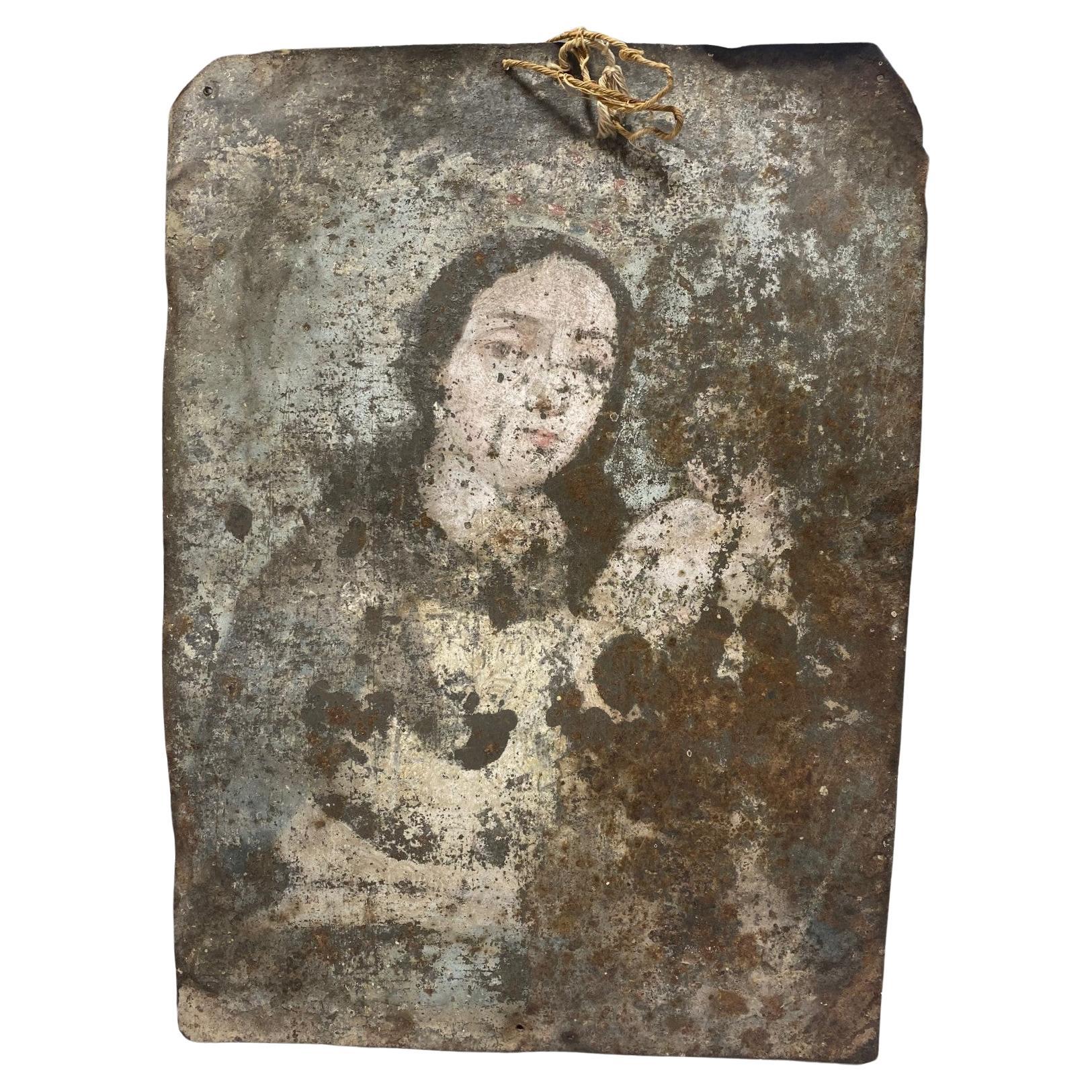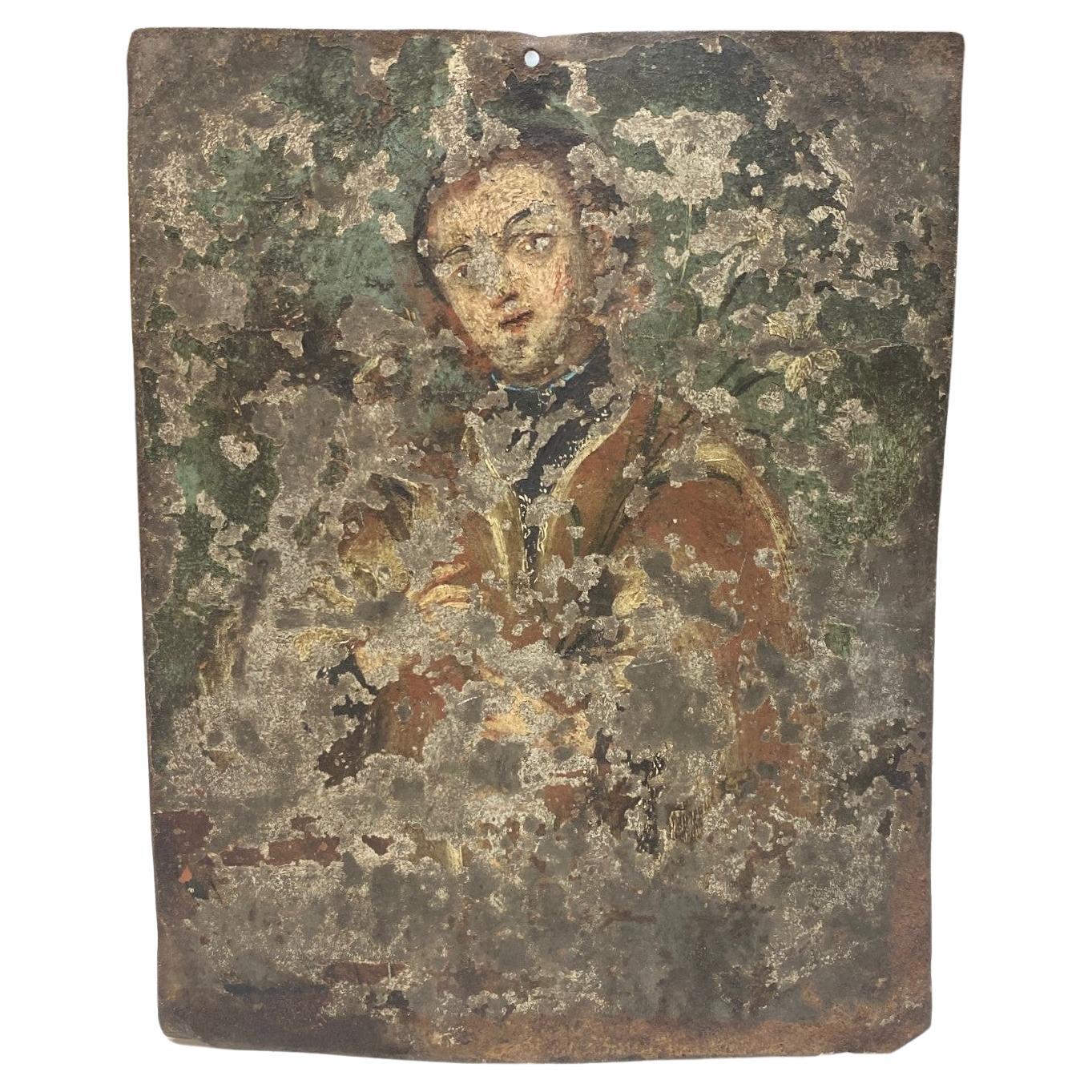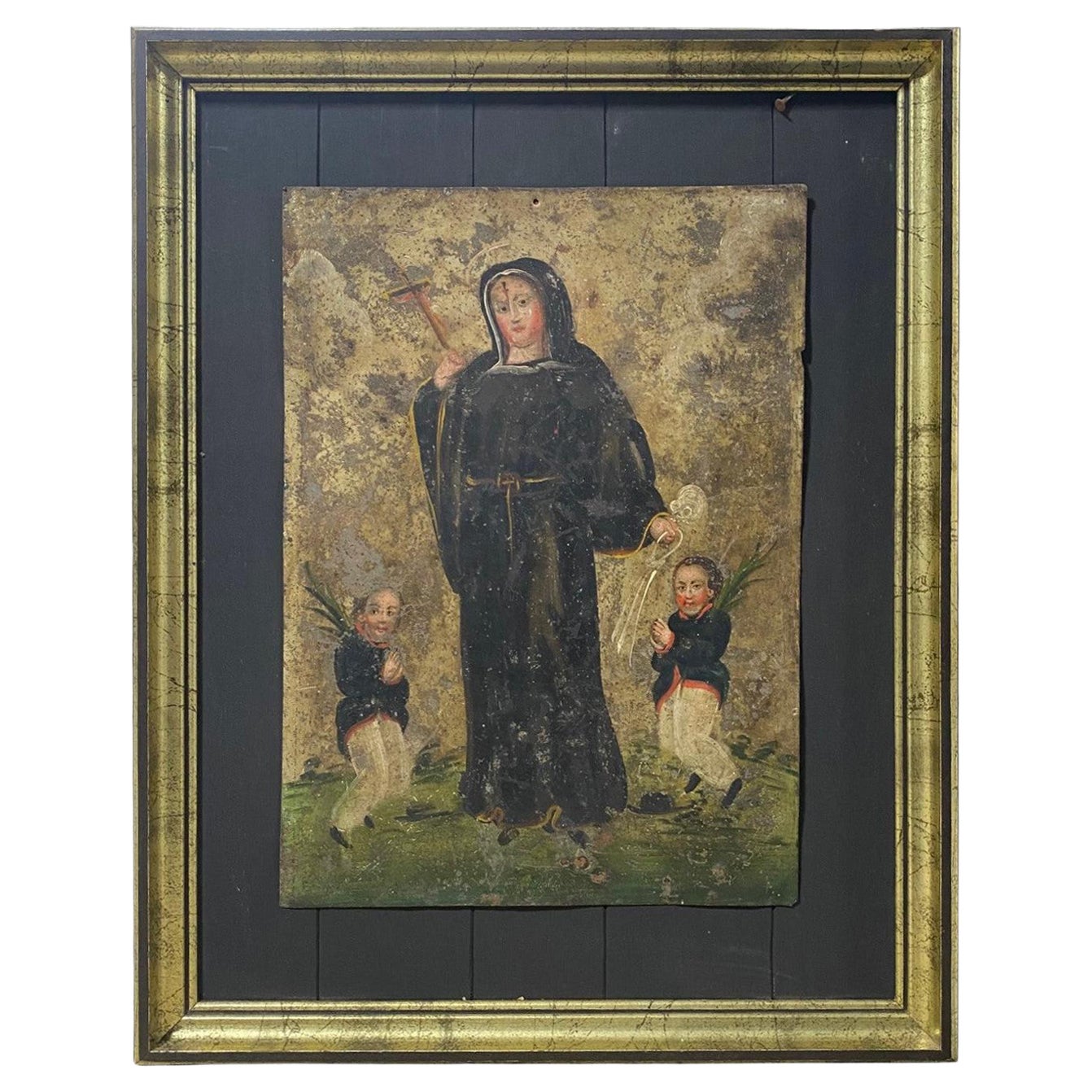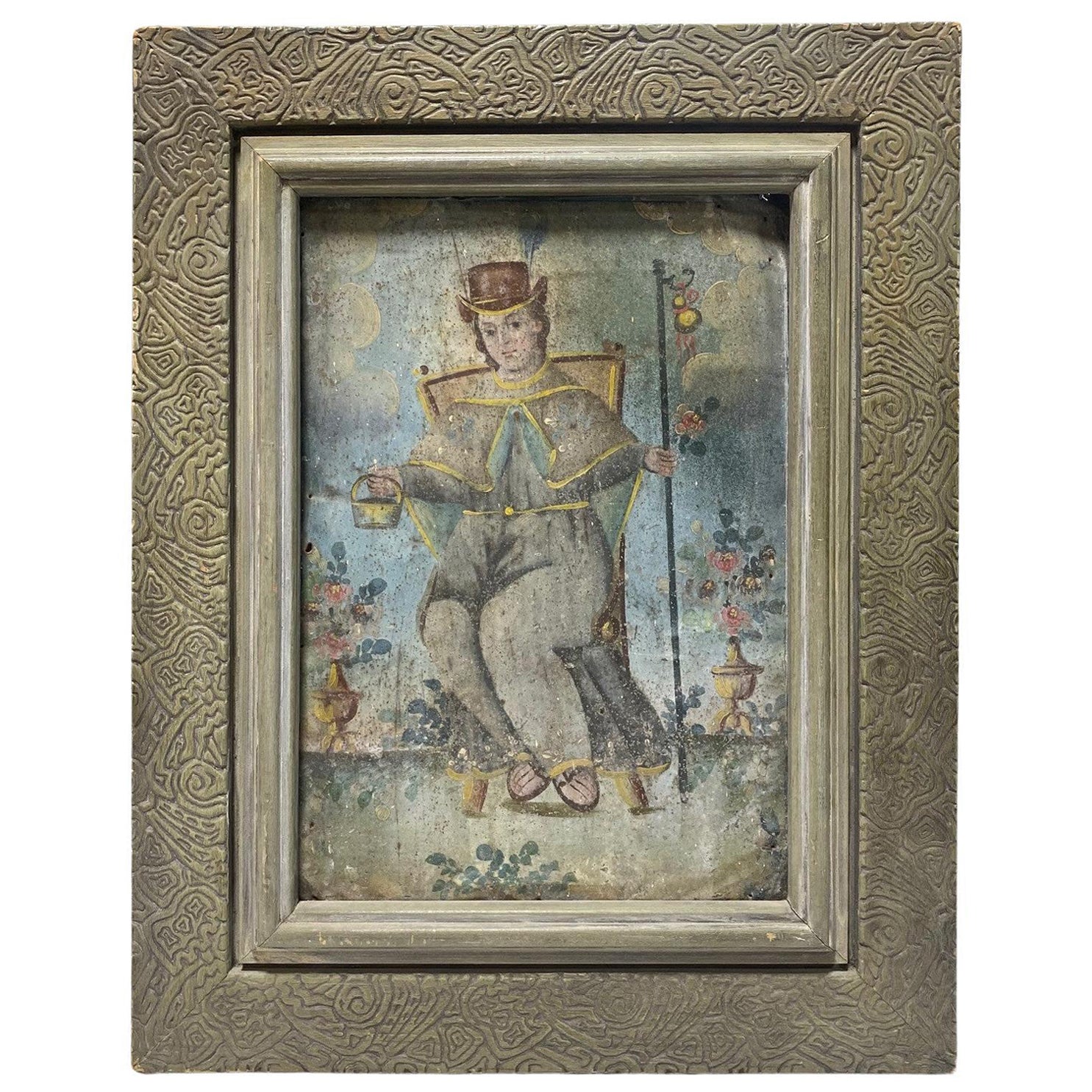Items Similar to Colonial Mexican Folk Art Ex-Voto Retablo Painting of Mother Mary & Jesus, 1800s
Want more images or videos?
Request additional images or videos from the seller
1 of 21
Colonial Mexican Folk Art Ex-Voto Retablo Painting of Mother Mary & Jesus, 1800s
About the Item
A beautiful 19th-century Spanish Colonial Mexican Folk Art ex-voto retablo lámina painting featuring Mother Mary with the crowned infant Jesus Christ (standing on clouds) in her arms. A beautiful, timeless, mesmeric image.
The work is hand-painted on metal (likely tin). Ex-votos and retablos are often placed above the altars in churches or family shrines as votive offerings made in the form of religious pictures/images typically portraying Christ and/or the Christian saints.
A truly wonderful, abstract, highly engaging, decrepit, beautiful piece with clear character and a wonderful patina acquired with age. Would make for a great addition to any Mexican Folk Art collection or eye-catching stand-alone accent work in about any setting once displayed and/or framed.
Dimensions: 14" high, 10" wide
- Dimensions:Height: 14 in (35.56 cm)Width: 10 in (25.4 cm)Depth: 0.15 in (3.81 mm)
- Style:Folk Art (Of the Period)
- Materials and Techniques:
- Place of Origin:
- Period:
- Date of Manufacture:19th Century
- Condition:In very good vintage condition with natural organic loss and wear consistent with age and use (please see photos). Beautiful and engaging overall.
- Seller Location:Studio City, CA
- Reference Number:1stDibs: LU2254338631272
About the Seller
4.9
Platinum Seller
These expertly vetted sellers are 1stDibs' most experienced sellers and are rated highest by our customers.
1stDibs seller since 2016
766 sales on 1stDibs
Typical response time: <1 hour
- ShippingRetrieving quote...Ships From: Studio City, CA
- Return PolicyA return for this item may be initiated within 7 days of delivery.
More From This SellerView All
- Colonial Mexican Folk Art Ex-Voto Retablo Painting of Mother Mary & Jesus, 1800sLocated in Studio City, CAA beautiful 19th-century Spanish Colonial Mexican Folk Art ex-voto retablo lámina painting featuring Mother Mary with the infant Jesus Christ (faded and now almost a ghost-like figur...Category
Antique 19th Century Mexican Folk Art Paintings
MaterialsMetal, Tin
- Colonial Mexican Folk Art Ex-Voto Retablo Painting of Jesus Angel Saint 1800sLocated in Studio City, CAA beautiful 19th-century Spanish Colonial Mexican Folk Art ex-voto retablo lámina painting featuring a crucified Jesus Christ, angel, or saint (possibly Saint Sebastian who was a Rom...Category
Antique 19th Century Mexican Folk Art Paintings
MaterialsWood, Paint
- Spanish Colonial Mexican Folk Art Ex-Voto Retablo Painting Catholic Saint 1800sLocated in Studio City, CAA beautiful 19th-century Spanish Colonial Mexican Folk Art ex-voto retablo lámina painting featuring an unknown Spanish Roman Catholic Saint. The work is hand-painted on metal (li...Category
Antique 19th Century Mexican Folk Art Paintings
MaterialsMetal, Tin
- Colonial Mexican Folk Art Ex-Voto Retablo Painting of Saint Rita De Cascia 1800sLocated in Studio City, CAA beautiful 19th century Spanish Colonial Mexican Folk Art ex-voto retablo lámina painting featuring Saint Rita De Cascia. Santa Rita is almost always depicted as she is here, with a trickle of blood and a thorn deeply embedded in her forehead. According to legend, in the year 1441, during a sermon on the Crown of Thorns, Santa Rita prayed so intently that a thorn detached itself from her crucifix and lodged itself in her forehead. For the next fifteen years, she bore this external sign of stigmatization and union with Christ. It was said her wound became so disturbing to view, that she spent the latter part of her life in isolation and prayer. At her canonization ceremony in the year 1900, Santa Rita de Cascia was bestowed the title of Patroness of Impossible Causes. In Mexico, Santa Rita is widely venerated as the Patroness Saint of mothers, abused wives, and heartbroken women. In this work, she is flanked by two small male figures representing her two beloved sons (notice the fine attention to the paintings of their faces and their glowing rosy red cheeks). She holds a large crucifix in one hand and a flagella whip, symbolizing her practice of mortifying the flesh, in her other hand. The work is hand painted on metal (likely tin). Ex-votos and retablos are often placed above the altars in churches or family shrines as votive offerings made in the form of religious pictures...Category
Antique 19th Century Mexican Folk Art Paintings
MaterialsMetal, Tin
- Colonial Mexican Folk Art Ex-Voto Retablo Painting of Santo Niño de Atocha 1800sLocated in Studio City, CAA beautiful 19th-century Spanish Colonial Mexican Folk Art ex-voto retablo lámina painting featuring Santo Niño de Atocha (also known as - Holy In...Category
Antique 19th Century Mexican Folk Art Paintings
MaterialsMetal, Tin
- Russian Icon Painting Theotokos Vladimir Madonna Mother Mary Child Jesus ChristLocated in Studio City, CAA beautifully engaging, darkly nuanced Theotokos of Vladimir Russian icon (or possibly Our Lady of Kazan Icon/Mother of God of Kazan) tempera painting (and possibly gold leaf) on a wooden panel featuring the Madonna (Mother Mary) and infant child (a baby Jesus Christ) in her arms. Theotokos is the term for an Eastern icon...Category
Antique 19th Century Russian Paintings
MaterialsWood, Paint
You May Also Like
- Vintage Mexican Religious Folk Art Ex-voto Retablo Arcangel San MiguelLocated in Forney, TXA framed vintage oil on tin ex-voto retablo Arcangel San Miguel, Spanish Colonial Mexican religious folk art. Primitive hand-painted tin panel, marked Guanajuato, Mexico, dated 19??, offered to Arcangel San Miguel (Archangel Michael), with hand-written inscription in lower margin. Professionally framed and matted. An ex-voto is a votive offering to a saint or a divinity, given in fulfillment of a vow (hence the Latin term, short for ex voto suscepto, "from the vow made") or in gratitude or devotion. Usually praying for a family member or close friend, with pictorial depicting that persons situation. The term ex-voto is usually restricted to Christian examples. Ex-votos are placed in a church or chapel where the worshiper seeks grace or wishes to give thanks. The destinations of pilgrimages often include shrines with the walls decorated with ex-votos. Ex-votos can take a wide variety of forms. They are not only intended for the helping figure, but also as a testimony to later visitors of the received help. As such they may include texts explaining a miracle attributed to the helper, or symbols such as a painted or modeled reproduction of a miraculously healed body part, or a directly related item such as a crutch given by a person formerly lame. There are places where a very old tradition of depositing ex-votos existed, such as Abydos in ancient Egypt. Ex-voto paintings, especially in the Latin world, there is a tradition of votive paintings, typically depicting a dangerous incident which the offeror survived. The votive paintings of Mexico...Category
Mid-20th Century Mexican Folk Art Outsider and Self Taught Art
MaterialsTin
- Cuzco School Ex Voto Painting of St. Joseph Holding The Christ Child.Located in Montreal, QCCuzco often has unusual iconography but this painting is perhaps unique. Saint Joseph, his hand raised in benediction cradles the child Christ with his own little crown of thorns and...Category
Antique 1850s Peruvian Folk Art Paintings
MaterialsPaint
- 19th C. Mexican Retablo, C.1880Located in San Francisco, CAABOUT An original 19th century Mexican folk retablo. Oil paint on tin. Subject unknown. CREATOR Unknown. DATE OF MANUFACTURE c.1880. MATERIALS AND TECHNIQUES Oil Paint on Tin. CONDITION Good. Wear consistent with age and use. DIMENSIONS H 14 in. W 10 in. HISTORY Retablos, better known as 'laminas' in Mexico, are small oil paintings on tin, wood and sometimes copper which were used in home altars to venerate the almost infinite number of Catholic saints. The literal translation for 'retablo' is 'behind the altar.' This unique genre of art, deeply rooted in European history, was brought to Mexico with the arrival of the Spanish and then ultimately adopted by New World mestizo natives to become what is known today as the Mexican folk retablo. The retablo was an art form that flourished in post conquest Mexico and then ultimately, with the introduction of inexpensive mediums such as tin, reached its pinnacle of popularity in the last quarter of the 19th century. With some exceptions, mostly untrained artists from the provinces worked to produce and reproduce these sacred images; some subjects painted more prolifically than others. A typical "retablero" may have reproduced the same image hundreds, if not thousands of times in his or her career. These oil paintings were sold to devout believers who displayed them in home altars to honor their patron saints. There are virtually hundreds of saints, each invoked to remedy a different situation. "San Ysidro Labrador," the patron saint of farmers, is venerated for good weather...Category
Antique 19th Century Mexican Folk Art Paintings
MaterialsTin
- 19th Century Mexican Religious RetabloLocated in Ross, CAAntique Mexican retablo made in 1890 which includes a woman praying to the Virgin Mary and Jesus Christ. Framed in wooden frame ornately carve...Category
Antique 1890s Mexican Folk Art Paintings
MaterialsTin
- 19th C. Mexican Retablo Saint Francis c.1880Located in San Francisco, CAAbout An original 19th century Mexican folk retablo of Saint Francis. Oil paint on tin. St. Francis of Assisi, Italian San Francesco d’Assisi was born 1181-1182 in Assisi, duchy of Spoleto, Italy and died October 3, 1226. He was canonized July 16, 1228. He founded the Franciscan orders of the Friars Minor and the lay Third Order. He was also a leader of the movement of evangelical poverty in the early 13th century. His evangelical zeal, consecration to poverty, charity, and personal charisma drew thousands of followers. Francis’s devotion to the human Jesus and his desire to follow Jesus’ example reflected and reinforced important developments in medieval spirituality. Cretor Unknown. Date of manufacture c.1880. Materials and techniques Oil Paint on Tin. Condition Good. Wear consistent with age and use. Dimensions H 14 in. W 10 in. History Retablos, better known as 'laminas' in Mexico, are small oil paintings on tin, wood and sometimes copper which were used in home altars to venerate the almost infinite number of Catholic saints. The literal translation for 'retablo' is 'behind the altar.' This unique genre of art, deeply rooted in European history, was brought to Mexico with the arrival of the Spanish and then ultimately adopted by New World mestizo natives to become what is known today as the Mexican folk retablo. The retablo was an art form that flourished in post conquest Mexico and then ultimately, with the introduction of inexpensive mediums such as tin, reached its pinnacle of popularity in the last quarter of the 19th century. With some exceptions, mostly untrained artists from the provinces worked to produce and reproduce these sacred images; some subjects painted more prolifically than others. A typical "retablero" may have reproduced the same image hundreds, if not thousands of times in his or her career. These oil paintings were sold to devout believers who displayed them in home altars to honor their patron saints. There are virtually hundreds of saints, each invoked to remedy a different situation. "San Ysidro Labrador," the patron saint of farmers, is venerated for good weather...Category
Antique 19th Century Mexican Folk Art Paintings
MaterialsTin
- 19th C. Mexican Retablo "Veronica's Veil", c.1880Located in San Francisco, CAAbout An original 19th century Mexican folk retablo "Veronica's Veil" or "El Divono Rostro" in Spain . Oil paint on tin. The Veil of Veronica, known in Italian as the Volto Santo or Holy Face, is a Roman Catholic Relic which, according to legend, bears the likeness of the Face of Jesus that was imprinted on it prior to Jesus' crucifixion. According to Roman Catholicism, Saint Veronica encountered Jesus in Jeruselum on the way to Calvary. When she paused to wipe the sweat (Latin, suda) off his face with her veil, his image was left on the veil. In the small village of Osa de la Vega in Spain, there lived a couple who led a very pious life. They were Gregorio de la Torre and Isabel Corral. From their father, Juan Montilla, they inherited a picture of the Face of Jesus or the Divino Rostro. A story that is told one day, to the amazement of many who confirmed its veracity, the picture began to perspire with living blood. News of this extraordinary event spread swiftly and widely throughout the land. CREATOR Unknown. DATE OF MANUFACTURE c.1880. MATERIALS AND TECHNIQUES Oil Paint on Tin. CONDITION Good. Wear consistent with age and use. DIMENSIONS H 14 in. W 10 in. HISTORY Retablos, better known as 'laminas' in Mexico, are small oil paintings on tin, wood and sometimes copper which were used in home altars to venerate the almost infinite number of Catholic saints. The literal translation for 'retablo' is 'behind the altar.' This unique genre of art, deeply rooted in European history, was brought to Mexico with the arrival of the Spanish and then ultimately adopted by New World mestizo natives to become what is known today as the Mexican folk retablo. The retablo was an art form that flourished in post conquest Mexico and then ultimately, with the introduction of inexpensive mediums such as tin, reached its pinnacle of popularity in the last quarter of the 19th century. With some exceptions, mostly untrained artists from the provinces worked to produce and reproduce these sacred images; some subjects painted more prolifically than others. A typical "retablero" may have reproduced the same image hundreds, if not thousands of times in his or her career. These oil paintings were sold to devout believers who displayed them in home altars to honor their patron saints. There are virtually hundreds of saints, each invoked to remedy a different situation. "San Ysidro Labrador," the patron saint of farmers, is venerated for good weather...Category
Antique 19th Century Mexican Folk Art Paintings
MaterialsTin





